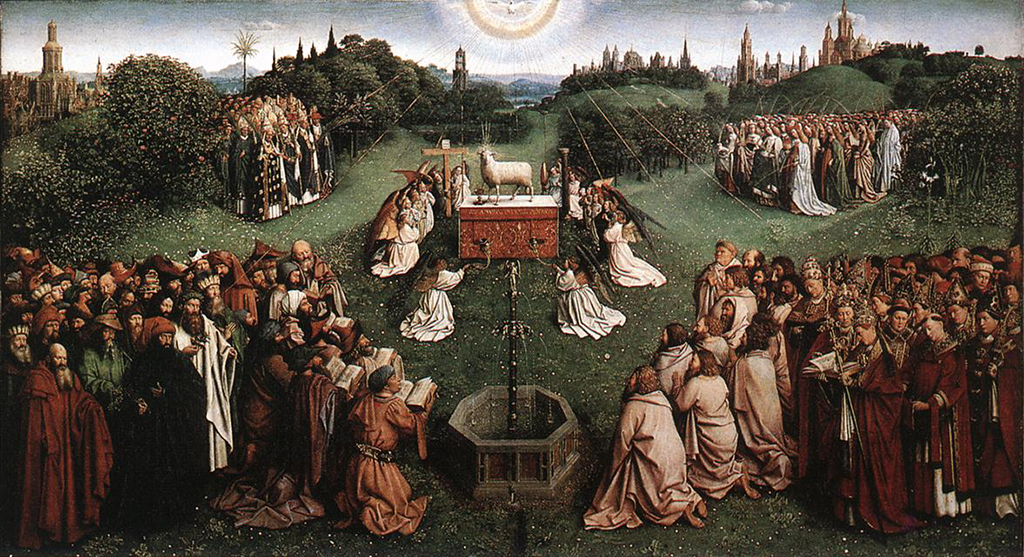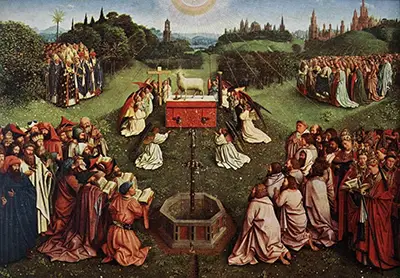The Adoration of the Mystic Lamb is the central panel of the groundbreaking Ghent Altarpiece that was completed by Jan van Eyck and his brother in around 1432
Indeed, the importance of this part of the work has meant that sometimes the entire altarpiece is simply referred to with this name. The overall Ghent Altarpiece, with its 18 panels in total, is discussed in further detail elsewhere in this site, but this page focuses specifically on the central panel.
Whilst much of Van Eyck's work is spread thinly around the European continent, it is pleasing to discover that this complex piece remains in its intended location, Ghent. The painting holds a huge importance to this city and is unlikely to ever be sold, with it now being owned by the state.
This elaborate panel was produced through layering of oil paints, including transparent elements which lifted the final look and gave an almost divine lighting that still impresses today. The oak panel would have been set in position through a natural glue. It is perhaps paintings such as this that ultimately persuaded the Italian renaissance artists to move away from their previous preference for egg tempera.
The cityscape that sits in the background of this panel features the towers of Ghent, many of which still remain there today (there has been some discussion over whether some of the landscape actually depicts the city of Utrecht). It is a touching connection between the painting and its intended location. Then rest of the scene is entirely self-explanatory from the title, with a lamb sitting in the middle of the composition, surrounded by admiring followers.
The overall altarpiece has quite an interesting history, with several panels stolen at various times. The city of Ghent remain exceptionally proud of this artwork and are hopeful that the panel that still is missing will one day return to its rightful home. For now, a reproduction panel has been put in its place. Beyond the thefts, damage has also occurred through its storage over the past few centuries, with restoration work have been completed as recently as 2012. A team of around 11 restorers have ensured its survival for centuries to come, though much of the work was completed on the outer panels, not this central piece.
Explanation of the Content of the Adoration of the Mystic Lamb Central Panel
If we study the panel painting from the top left corner and travel in an anti-clockwise direction, we will see the following: male martyrs, pagan writers and Jewish prophets, male saints and finally several female martyrs.
The central panel measures 237.5cm wide, by 134.3cm tall. That is relatively large when compared to most of his one-off paintings, probably due to the fact that this piece was for public display rather than private worship. The Lamb of God sits as its centerpiece, with a small foundation placed just below. The five groups of figures are dotted across the sprawling hills which capture the beauty of the North European landscape.
There are 14 angels surrounding the lamb who stands on an altar. There is a injury to the animal, though without any signs of distress which is perhaps a reminder of Christ's own sacrifice, as taught in the teachings of Christianity. The accessories held by the angels also provide further symbolism with regards Christ's passion - see the cross and crown of thorns, for example.
"...Behold the Lamb of God who takes away the sins of the world..." is written in Latin upon the altarpiece, underlining the precise meaning of the use of the lamb. The words have been taken from John 1:29 and attempt to enforce a feeling of appreciation and devotion from those who would view the piece in its final resting spot in Ghent.
Those taking a step back to appreciate the role of this panel within the overall piece may make an interesting discovery by scanning vertically through the centre. The Holy Trinity is represented with the lamb as Jesus and God the Father sitting in the panel immediately above the Adoration of the Mystic Lamb. The Holy Spirit is likewise symbolised by the dove that flies around the lamb.
In order to be able to fully appreciate the beauty of this specific panel, we have included a larger photograph of it below.

At the foot of this painting is a large fountain, placed centrally in order to connect with the other symbols that sit along the same vertical line. The stream of water from the fountain is intended to give the impression of life. Indeed, this is clarified by the inscription that is placed on the rim of the fountain, which translates from the original Latin to, "...This is the fountain of the water of life, proceeding out of the throne of God and of the Lamb...". Thus the central passage from the top panel down to the fountain in this piece is understood.
One of the greatest qualities of this panel painting is the extraordinary level of detail included by the artist - you will be able to see it in the larger image displayed here. The accuracy with which Van Eyck depicted the vegetation, for example, would surely not have been possible without considerable study and practice. Sadly, very few of his study drawings still exist, making this a hard conclusion to draw confidently.
The background scenery, featuring rolling hills, churches and towers also continues this exceptional attention to detail and makes this a painting that really must be seen in person in order to be fully understood and appreciated. To find similar work from other famous artists is difficult, such was the brilliance and imagination of Jan van Eyck, but certainly comparisons can be drawn with the likes of Hieronymus Bosch's Garden of Earthly Delights and also several Pieter Bruegel landscape scenes, such as Hunters in the Snow.
The turbulent history of the Netherlandish regions meant that this altarpiece was close to destruction on several occasions, most notably in 1566 and 1576. Rioters were attempting to burn this beautiful artwork but enough security was provided to repel them both times. Famous art has frequently drawn controversy from within society for all manner of reasons, sometimes as a result of an artist seeking to push boundaries that others are unwilling to move.
There are innovations in this central panel, some of which maybe too subtle to find on first viewing. The manner in which Van Eyck captures the reflections of the water in the fountain, for example, had not been seen before outside of the Netherlandish region. Much of the other work from this period was destroyed centuries later, making this one of the few surviving examples of that technique.




